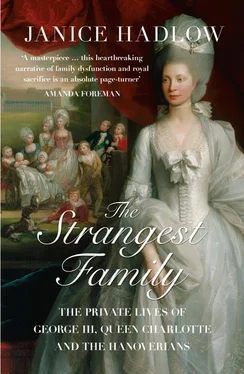In the spring, the king’s search began to move towards a conclusion. In May, Caroline of Darmstadt was finally and decisively eliminated from his thinking, as disturbing new facts emerged about her family. The apparent piety of her father and his court had at first seemed attractive to George, who hoped his wife would share his own strong Christian convictions. But fresh information put a far darker complexion on the family’s spiritual pursuits. The king was horrified to learn that the Prince of Darmstadt had been drawn into the orbit of a group of religious visionaries who had driven him to the edge of reason. George had been told that these ‘ visionnaires ’ had ‘got about the princess’s father, have persuaded him to quit his family in great measure, lest the hereditary princess should prevent their strange schemes; they have brought the prince very near the borders of madness, and draw his money to that degree from him, that his children are often in want of necessaries such as stockings, etc.’. He had also discovered that ‘this princess was talked of last year’ for another prince, who had ‘refused her on account of her strange father and grandfather’. 15Was George prepared to take a risk another man had already declined?
He brooded for a fortnight, then on 20 May he wrote to Bute with his final decision: ‘The family of the Princess of Darmstadt has given me such melancholy thoughts of what may perhaps be in the blood.’ The possibility of madness was not an inheritance any ruler wanted to import into his bloodline, and put an end to the candidacy of Caroline of Darmstadt. As a result, the seventeen-year-old Charlotte of Mecklenburg-Strelitz, who had begun as a complete outsider – little more than a chance addition to Munchausen’s list – ended up bearing away the crown. ‘I trouble my Dearest Friend with the enclosed account of the Princess of Strelitz,’ wrote George. ‘I own it is not in every particular as I could wish, but yet I am resolved to fix here.’ 16
*
In the eighteenth century, Mecklenburg-Strelitz was considered very much a rural backwater. The duchy was then about the size of Sussex, and in the hierarchy of German princely states was in the second or perhaps even third division. Such was its reputation for mud and provinciality that it was sometimes referred to by heavy-handed contemporary jokers as ‘Mecklenburg-Strawlitter’. In 1736, when he was still Crown Prince of Prussia, Frederick the Great paid a surprise call on the Mecklenburg dukes, arriving unannounced at the family castle of Mirow. There was little evidence of the Prussian military discipline that reigned in Berlin. He wrote to his father that, ‘Coming on to the drawbridge, I perceived an old stocking-knitter disguised as a grenadier, with his cap, cartridge and musket laid aside so that they might not hinder his knitting.’ Gaining access to the castle proved a task in itself. ‘After knocking almost half an hour to no purpose, there peered out at last an exceedingly old woman. She was so terrified that she slammed the door in our faces.’ When Frederick finally met someone with enough self-possession to take him to the ducal family, he was promptly invited to dinner.
At the duke’s table, Frederick was surprised to see some of the ladies darning stockings during the meal. 17He was even more shocked to discover that sewing was not an activity confined to the female members of the family. The duke himself was a passionate devotee of needlework, said to embroider his own dressing gowns in his spare time, having achieved considerable skill in the art through years of practice. This was an eccentric pursuit for an aristocratic man (Frederick clearly thought it evidence of mild derangement) but neither the duke nor his relatives seemed embarrassed by it. On the contrary, over supper, madness formed the principal subject of discussion. ‘At table, there was talk of nothing but of all the German princes who are not right in their wits – as Mirow himself is reputed to be. There was Weimar, Gotha, Waldeck, Hoym and the whole lot brought on the carpet; and after our good host had got considerably drunk, he lovingly promised me that he and his whole family will come to visit me.’ 18It was fortunate for George III’s future wife that none of these rumours reached the ears of the king, finely attuned as they were to any hint of inherited mental instability.
This was the world into which Princess Sophia Charlotte was born in 1744. The embroidering duke was her grandfather. Life was quiet for the Mecklenburg family in their compact palace, so small that Frederick had mistaken it for the parsonage. Charlotte had four brothers and an elder sister, Christiane (who at twenty-five was considered too old to be a wife for the twenty-two-year-old George III). Her father’s death, in 1752, when she was only eight, must have disturbed the placid passing of the days, but little else seems to have impacted on an early life distinguished by its lack of event. ‘The princess lived in the greatest retirement,’ one contemporary observer noted. ‘She dressed only in a robe de chambre , except on Sundays, on which day she put on her best gown and after service, which was very long, took an airing in a coach and six, attended by guards. She was not yet allowed to dine in public.’ 19Charlotte’s mornings were devoted to the reigning family passion, sewing, in one of its many ornamental forms; she was inducted into the discipline of the needle very early, and never lost her taste for it when she was both older and grander. ‘Queen Charlotte, as we know, always had her piece of work in hand,’ recalled one of her more unctuous biographers. What had been in her grandfather adduced as possible evidence of insanity was regarded in Charlotte as an admirable demonstration of female industry. Her sewing skills, however, did not displace more academically minded pursuits. Charlotte’s mother took the education of her daughters seriously, and by the time Charlotte was seven she was already in the schoolroom. The sisters were instructed by Mme de Grabow, a poet whose local fame had earned her the title of ‘the German Sappho’. 20Besides teaching poetic composition and the rudiments of French – then considered an essential part of a polite education – Mme de Grabow also gave lessons in Latin. This was an unusual subject for girls: classical learning was generally considered the exclusive preserve of masculine study. Charlotte and Christiane were also taught theology by a Dr Gentzner, but the study of religion seems to have been secondary to his real passion, which was natural history. He was an accomplished botanist who awakened a similar enthusiasm in Charlotte. From her youth, she was a keen collector of plant specimens, preserving those she found most interesting in voluminous sketch books.
By the time she was in her early teens, Charlotte had already developed the bookish tastes that would stay with her for the rest of her life. She was a voracious reader, devouring serious works of literature, theology and philosophy; whatever she could beg, buy or borrow she would consume with an intensity that belied her otherwise docile demeanour. But her intellectual journeys were undertaken alone. The remoteness of Mecklenburg ensured she had no access to sophisticated thinking of the kind that had so stimulated Queen Caroline. Her parents were committed Lutherans who viewed with deep suspicion any form of study which sought to question the foundations of sacred truths. There was no Leibniz at the small, rural court to stretch her mind, and no protective cadre of like-minded, clever women to encourage her curiosity. Perhaps as a result of her intellectual isolation, Charlotte drew very different conclusions from her reading. Without the debate and provocation that had encouraged Caroline to explore unorthodox opinion, Charlotte’s values were unchallenged by what she read. Unlike Caroline, who was always suspected of harbouring suspiciously radical ideas about the truth of revealed religion, Charlotte’s intellectual explorations never undermined the traditional beliefs in which she had been so scrupulously raised. Her studies made her a bluestocking, 21but she was never a philosophe . While she immersed herself in the products of the Enlightenment, she did not endorse its implied social and political progressivism. She once returned a copy of one of Voltaire’s book to a correspondent, announcing primly: ‘I do not want anything more of his.’ 22
Читать дальше












